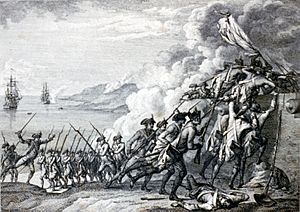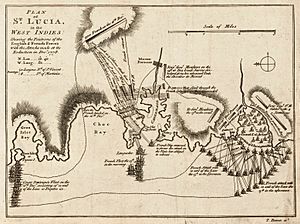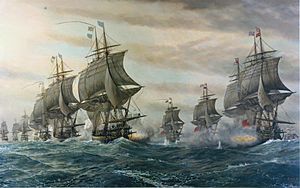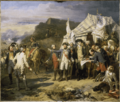Anglo-French War (1778–1783) facts for kids
Quick facts for kids Anglo-French War (1778–1783) |
|||||||||
|---|---|---|---|---|---|---|---|---|---|
| Part of the American Revolutionary War and the Anglo-French Wars | |||||||||
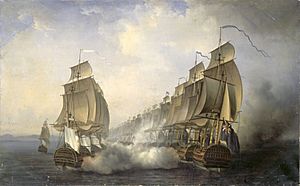 Battle of Cuddalore (June 20th 1783) between the French navy commanded by the Bailli de Suffren and the British one under the orders of Rear-Admiral Edward Hughes |
|||||||||
|
|||||||||
| Belligerents | |||||||||
|
|
|||||||||
| Commanders and leaders | |||||||||
| Comte d'Orvilliers Comte d'Estaing Comte de Grasse Bailli de Suffren |
Viscount Keppel John Byron Baron Rodney Edward Hughes |
||||||||
The Anglo-French War was a big conflict between France and Great Britain. It happened from 1778 to 1783. Sometimes their allies joined in too. This war made Britain shift its focus from the American War of Independence. They had to send soldiers and ships to places like Europe, India, and the West Indies.
From 1778 to 1783, France and Britain fought for control. They battled in the English Channel, the Mediterranean, the Indian Ocean, and the Caribbean.
When news of a British defeat in America reached France, King Louis XVI decided to help the Americans. This led to a formal Franco-American alliance. France then joined the war, making it a global conflict. Spain joined in 1779, helping France. Other countries like the Dutch Republic also got involved later. The war was very expensive, leading to protests in London in 1780.
France helped Spain fight Britain in places like Menorca and the Caribbean islands. Menorca and many Caribbean islands were captured by 1781. However, the French and Spanish faced big losses in 1782. They lost a major naval battle and failed to capture Gibraltar. France also had money problems and wanted peace.
Naval battles also took place in India. Admirals Edward Hughes and Pierre André de Suffren fought there. France tried to take over British lands in India but couldn't. Fighting stopped when they heard about the peace treaties.
The war helped America become independent. But it was very bad for France's finances. The huge cost led to France's own money problems six years later. This helped set the stage for the French Revolution.
Contents
Why the War Started
After the Seven Years' War, French foreign ministers believed that American independence would help France. It would also hurt Britain. They thought trying to get back old French lands would not help this goal. When the American rebellion started in 1775, France secretly supported the American rebels. They also prepared their navies for war.
By 1777, the American rebellion was in its third year. A big British defeat in America showed the war would be long and costly. This raised the chance of France joining the war. Britain's government tried to make peace with the Americans. They offered them more freedom. But by 1778, the Americans wanted full independence.
France wanted to keep its influence in Europe. But it was better for France to fight Britain in North America. This would hurt Britain more. France had changed its alliances in 1756, becoming friends with Austria. Many French people did not like this change. The French foreign minister, Comte de Vergennes, did not trust Austria. He worked to free France from its military duties to Austria by 1778.
France Joins the Fight (1778)
In December 1777, news reached Benjamin Franklin in France that the British had lost a major battle in America. Two days later, King Louis XVI agreed to an alliance with America. The treaty was signed in February 1778. France declared war on Britain a month later. Naval fights began in June near Ushant.
George III of Britain did not want war with France. But he was ready for it. He remembered Britain's wins against France in the Seven Years' War. In that war, France was busy fighting in Europe. Britain defeated the French navy and won in India, the West Indies, and North America.
However, Britain's situation in 1778 was different. They no longer had an alliance with Prussia. Britain was alone in Europe. They tried to find a European ally but failed. This meant France could focus all its power on Britain. There would be no other European wars to distract France.
France and Britain fought for control of the English Channel. This was part of the global war. The first big naval battle in Europe happened on July 27, 1778. It was 100 miles west of Ushant. Both fleets had 30 ships and fought for hours. Neither side won clearly.
Caribbean Battles (1778–1779)
The fighting in the West Indies was complicated. It involved battles for control of the seas. There were also raids on enemy ships and colonies. French ships blocked important British sugar islands like Barbados and Jamaica. Thousands of people died from hunger and sickness. More soldiers died from the climate and disease than from fighting.
Dominica was an important island. It was between French-held Martinique and Guadeloupe. Britain had captured it in 1761. Taking it back would help France communicate between its islands. It would also stop privateers from using Dominica's ports. In August 1778, the French governor of Martinique, François Claude Amour, the marquis de Bouillé, learned that war had begun.
De Bouillé quickly planned to take Dominica. He knew the island's defenses were weak. He also knew the British fleet was stronger than his. But the British admiral, Samuel Barrington, was ordered to keep most of his fleet at Barbados. De Bouillé kept his plans secret. He pretended to be peaceful with Dominica's leaders.
On September 5, de Bouillé learned that the British frigate had left. He attacked quickly. He defeated the British in Dominica in September 1778. De Bouillé left 800 soldiers there and returned to Martinique. This was the first of many island changes during the war.
News of Dominica's fall surprised London. Admiral Barrington was blamed for the loss. French Admiral d'Estaing arrived in the West Indies in December 1778. He had 12 ships. A British fleet also arrived, making their forces stronger. The British then captured French-held St. Lucia in December 1778. The British used St. Lucia to watch the main French base at Martinique.
More British ships arrived in January 1779. Admiral John Byron took command. By mid-1779, the French fleet was stronger. Byron left St. Lucia in June to protect British merchant ships. This left d'Estaing free to act. D'Estaing and de Bouillé attacked nearby British islands. They first took Saint Vincent on June 18. Then d'Estaing aimed for Barbados, a key British island. But he couldn't sail against the winds. So he turned to Grenada. The French fleet arrived at Grenada on July 2. They stormed its defenses on July 3. The British surrendered on July 4.
The first big French expedition to North America was in 1779. French Vice Admiral d'Estaing tried to invade British-held Savannah. He brought 20 ships and 3,000 soldiers. The American general, George Washington, did not fully cooperate. D'Estaing landed his troops to help the Americans. On October 9, 1779, the French and Americans attacked the city. But the British army was well-defended. They pushed back the attackers. D'Estaing was badly hurt and had to sail back to France.
War in India (1778–1780)
When news of the war reached India in 1778, the British East India Company quickly captured French outposts. They took Pondicherry after a two-month siege. In March 1779, the British won Mahé from the French. A local group, the Nairs, rebelled against their ruler, Haidar Ali. The British supported this uprising. But it was stopped, and the French retook Mahé in 1780 with Haidar Ali's help.
Spain Joins the War (1779–1780)
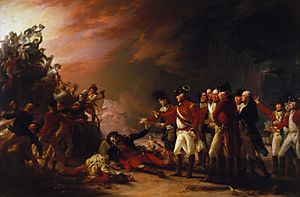
In April 1779, France and Spain signed an agreement. Spain wanted to get back Gibraltar and Minorca. They also wanted Mobile and Pensacola in Florida. Spain also aimed to remove the British from Spanish Central America. France wanted to stop British fishing rights in Newfoundland. They also wanted free trade in India and to get back Senegal and Dominica.
Spain entered the war to get back Gibraltar, which Britain had taken in 1704. Spain began a siege in June 1779. This was the longest siege of Gibraltar. The Spanish blocked the land around the Rock of Gibraltar. They also tried to cut off supplies by sea. But small, fast British ships could get through. By late 1779, supplies in Gibraltar were very low. The commander, General George Eliott, asked London for help.
A supply convoy was sent. In December 1779, a large fleet sailed from Britain. Admiral Sir George Brydges Rodney was in command. His main orders were to go to the West Indies. But he had secret orders to resupply Gibraltar and Minorca first. The supply ships reached Gibraltar on January 19, 1780. Rodney arrived a few days later. The British soldiers were happy to see the supplies. After resupplying Minorca, Rodney sailed for the West Indies. On his way, he captured some French supply ships.
In North America, the Spanish governor of Louisiana, Bernardo de Gálvez, attacked British forts in the south. He took them by surprise.
Failed Invasion of Britain (1779)
To ease pressure on other fronts, France and Spain planned to invade Great Britain in 1779. This plan was called the Armada of 1779. They wanted to capture the Isle of Wight and the British naval base of Portsmouth. The combined French and Spanish fleet had 66 ships. Their goal was to clear the English Channel for 30,000 to 40,000 soldiers to land.
Despite having more ships than the British, the invasion failed. There were many problems: navigation errors, bad communication, disease, food shortages, and bad weather. By September 3, the invasion leaders decided to retreat. They had failed to fight the British fleet. As many as 8,000 soldiers were sick. The invasion caused fear in Britain, but King George III was encouraged by its failure.
North America (1780–1781)
After d'Estaing returned to France, George Washington needed more French naval support in North America. In July 1780, Lieutenant General Comte de Rochambeau arrived in Newport with 6,000 French soldiers. He said that strong naval power was key to success. The Dutch were helping the American rebels by selling them weapons. Britain used this as a reason to declare war on the Netherlands in December 1780. Admiral Rodney spent 1780 and 1781 attacking Dutch Caribbean islands.
By December 1780, the war in North America was at a critical point. The American army had suffered big defeats. Their money was almost worthless. Public support for the war was low. Soldiers were unhappy about pay and conditions.
French military planners had to decide where to focus in 1781. After some failed attempts to work with the Americans, they decided to get more involved in North America. They also needed to work with Spain. Spain was interested in attacking Jamaica. But Spain wanted to deal with British attempts to help Gibraltar first.
As the French fleet prepared to leave Brest in March 1781, important decisions were made. The West Indies fleet, led by the Comte de Grasse, was told to go to Cap-Français. They would see what was needed to help Spain. France also gave America six million livres for the war. The French fleet at Newport got a new commander, the Comte de Barras. He was ordered to harass British ships near Nova Scotia and Newfoundland. The French army at Newport was told to join Washington's army near New York.
De Grasse was secretly told to help in North America after his stop at Cap-Français. The French general, Rochambeau, was told to tell Washington that de Grasse might be able to help. Washington later learned that de Grasse had the choice to come north.
De Grasse received these messages in July. Around the same time, the British general Cornwallis was preparing to occupy Yorktown, Virginia. De Grasse agreed to help. He sent a message saying he would reach the Chesapeake Bay by late August. But he could only stay until mid-October. His arrival made the French and American armies march to Virginia.
De Grasse reached the Chesapeake as planned. His troops helped Lafayette's army block Cornwallis. A British fleet tried to challenge de Grasse's control of the Chesapeake. But the French defeated them on September 5 at the Battle of the Chesapeake. The Newport fleet brought French siege equipment. The Siege of Yorktown and Cornwallis's surrender on October 19 ended major fighting in North America.
In March 1782, the British Parliament voted against continuing the war in America. News of the surrender at Yorktown and losses in the West Indies brought down the British government. The new government began peace talks. Even though fighting in America stopped, the war continued in other places. These included the West and East Indies, and Gibraltar.
Britain and the Atlantic (1780–1782)
In Britain, more people were against the expensive war. This led to protests in London in June 1780.
The war in the Atlantic was a stalemate by 1780. In January 1781, France failed to invade Jersey in the Channel Islands. Their landing force was defeated. The French Navy then suffered several defeats in its home waters. These were costly both militarily and financially. In December 1781, many French soldiers were lost when British ships captured transports. In April 1782, a larger battle took place near Ushant. The British captured two valuable French ships and two-thirds of their convoy. This was a big financial blow to France. More defeats followed, including the loss of a new French frigate. The last naval battle of the American Revolutionary War happened on December 12, 1782. A French-American convoy was defeated off Ferrol.
Caribbean (1781–1783)
In October 1781, a plan was made between de Grasse, the French fleet commander, and Francisco Saavedra de Sangronis, a Spanish official. The plan had three main goals:
- To help the Americans and defeat the British navy at New York.
- To capture the British Windward Islands.
- To conquer Jamaica.
The first goal was met when the British army surrendered at Siege of Yorktown in September 1781. De Grasse's fleet played a key role in that victory. He then sailed to the Caribbean. In November 1781, he learned the plan to conquer Jamaica was approved.
Jamaica was Britain's most profitable colony. Its sugar was worth more than all thirteen American colonies combined. King George III said he would risk Britain itself to protect its Caribbean islands. Sugar made up 20% of all British imports. Taking Jamaica would greatly hurt the British economy. This invasion was also seen as an alternative to the costly attempts to take Gibraltar.
While de Grasse waited for more ships for the Jamaica campaign, he captured St. Kitts in February 1782. Other British islands like Antigua, St Lucia, and Barbados remained British. Admiral George Rodney arrived in the Caribbean the next month with reinforcements. This gave the British a slight advantage in numbers.
On April 7, 1782, de Grasse left Martinique with 35 ships and over 100 cargo ships. He was going to meet a Spanish fleet and 15,000 soldiers for the Jamaica invasion. Rodney learned of this and sailed from St Lucia with 36 ships the next day.
British ships at this time had copper sheathing on their hulls. This protected them from marine growth and made them faster.
Between April 9 and 12, 1782, a British fleet under Admiral George Brydges Rodney defeated a French fleet under the Comte de Grasse at the battle of the Saintes. French losses were huge. Nearly 8,000 to 9,000 men were killed, wounded, or captured. Five French ships were lost. The French and Spanish plans to invade Jamaica were cancelled.
News of the battle reached France in June. It was met with sadness. The defeat was a big blow to King Louis XVI. The French navy minister called it "a grim disaster." By the end of 1782, the French were on the defensive in the Caribbean. The British navy was able to blockade French and Spanish ports.
East Indies (1782–1783)
Suffren, a French admiral, stopped a British attempt to take the Cape in early 1781. He attacked a British squadron at Porto Praya. He arrived in southern India a year later. On land, the French supported Hyder Ali in his war against the British East India Company. At sea, Suffren fought five intense battles against the British fleet in 1782 and 1783. British Admiral Edward Hughes knew that keeping his ships safe was vital for Britain in India. The fighting ended when news of the peace treaties arrived in early 1783. The situation in India ended in a stalemate.
Peace Talks and the End of the War
Serious peace talks began between Britain, France, and Spain. News from India often showed a stalemate. Britain still held all the French land they had captured there. But in the West Indies, France held all the land they had captured, except for one island. After the Battle of the Saintes, Britain gained the upper hand at sea. This weakened the French-American alliance. As a result, America and Britain began talks. Britain agreed to recognize the new 'United States'.
France could not make peace without Spain's agreement. Spain wanted Gibraltar back. So, Gibraltar became a main point in the peace talks. French troops and ships helped Spain in their attack on Gibraltar.

On September 18, 1782, the French and Spanish launched a huge attack on Gibraltar. They used floating batteries and many soldiers. But the attack was a huge and costly failure. All ten floating batteries were lost. News of this disaster reached Paris and Madrid by September 27. All hope then rested on defeating the British fleet coming to help Gibraltar. But the British convoy got through without problems. An attempt to defeat the British fleet failed. This further failure broke French and Spanish determination.
With Gibraltar safe and Rodney's victory at the Saintes, Britain's demands in the peace talks grew stronger. British diplomats refused to give up Gibraltar. France had done all it could to help Spain. The French diplomat Comte de Vergennes tried to get Spain to offer Britain other things for Gibraltar.
Vergennes was desperate for peace. France's war costs were huge. They had almost run out of money to borrow. The French navy had lost many ships, especially in 1782. New taxes were put in place to pay for the war.
Soon after Gibraltar was relieved, Vergennes quickly restarted talks. France accepted the peace treaty between Britain and America on November 30. Preliminary treaties were signed with Britain, France, and Spain on January 20, 1783. The siege of Gibraltar was lifted three days later. News of the peace in India did not arrive until June.
What Happened Next
After the peace, France and Britain returned almost all the lands they had taken from each other since 1778.
For France, the war results were mixed. They succeeded in helping America become separate from Britain. But their gains were small. They got the tiny island of Tobago and some land around the Senegal River in Africa. France could not reverse its losses from 1762. India, Canada, and Britain's West Indian colonies remained British.
Britons were not too upset by the loss of America. Trade and cultural ties quickly returned between America and Britain. Britain actually traded more with its former colonies than France did. As the French foreign minister Vergennes said, "The English buy peace rather than make it."
However, the war's cost left a big mark on France. Over 1.3 billion livres were spent. This huge debt led to major money problems in France. It eventually led to the French Revolution in 1789.
See Also
Images for kids
-
The Sortie made by the Garrison of Gibraltar in the Morning of the 27 of November 1781 by John Trumbull, depicting a British attack that occurred during the Great Siege of Gibraltar
-
Rochambeau and Washington ordering at Yorktown; Lafayette, bareheaded, appears behind
-
The Siege of Gibraltar, 1782, showing the defeat of the Franco-Spanish assault in September 1782 by George Carter



